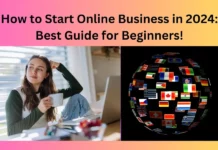Digital marketing can be described as a kind of marketing that requires the utilization of online channels like social media, emails as well as search engines and websites to advertise a particular product or service. It is a mix of methods and strategies which are employed to connect and engage potential customers on the internet.
Nowadays Professional Marketers use different effective techniques. A few of the most common digital marketing techniques are as follows:
The Search Engine Optimization (SEO) SEO involves enhancing your website and the content of it to appear higher in search results (SERPs). This includes identifying keywords relevant to your site and creating content of high-quality, and enhancing website performance and user-friendliness.
Social Media Marketing Facebook, Instagram, and Twitter can be utilized as the top social media platforms to advertise items and products, increase brand recognition, and interact with clients.
Pay-Per-Click advertising (PPC) PPC entails advertising on search results or social media platforms, and then paying for every click the ad gets. This is a great method of driving significant traffic to your site and can also generate leads.
Mail Marketing: Sending out promotional emails using email marketing can help create the list of subscribers marketing a product or service and to increase brand recognition and help nurture leads.
Content Marketing: The art of creating relevant and useful information that entices and entices potential customers to keep them engaged. This can be done through infographics videos blog posts, blogs and other things.
Digital marketing is always evolving and it is vital for companies to stay up-to-date with the latest trends and best practices to remain at the top of their game in an online market.
Marketing through digital channels can become complicated however there are some basic steps that can assist you in the process:
Determine your audience’s needs Before beginning any digital marketing program it is essential to determine your people. This will allow you to tailor your message and select the most efficient ways to reach them.
Create your goals: Your goals must be specific, quantifiable and aligned with the broad business goals.
Choose your channels: based on your audience’s preferences and your goals, pick the channels you’ll use to advertise your service or product. This can include social media and SEO (search engine optimization (SEO) as well as email marketing, pay per click advertising (PPC) and content marketing.
Create content Based on the channel that you’ve picked, you’ll be required to write various types of content like blog videos, posts and social media posts and email marketing campaigns.
Launch your campaigns: When you’ve got the content you want to use you can launch your campaigns. Create Facebook and Twitter accounts. set up your email campaigns, and then begin operating the PPC ads.
Review and analyze your results Monitor and measure your results: Track your marketing efforts on the internet and evaluate their effectiveness with tools like Google Analytics. Make use of this data to create improvements and tweaks to your marketing campaigns.
Keep up-to-date on industry trends The world of digital marketing is continuously changing, which is why it’s crucial to keep abreast of the latest trends and most effective methods. Participate in industry events as well as read blogs and other publications and keep studying new strategies and technology.
Be aware that digital marketing is a continuous process, so make sure to modify your strategies and tactics based on your outcomes and the shifting environment.
Digital marketing strategies are an extensive plan that describes the way a company will use digital media to achieve its goals in marketing. It’s a structure that guides the design and implementation of digital marketing strategies, making sure that they’re in line with the company’s objectives and the target market.
Digital marketing strategies are created to reach a specific audience and engage them effectively and in a efficient manner. The strategy can include different strategies for digital marketing like SEO, content marketing PPC as well as social media, email marketing and mobile marketing.
- A digital marketing strategy can help companies to:
- Establish a strong online presence
- Enhance brand awareness
- Develop leads and sales
- Engage with your customers and create relationships with them.
- Assess and monitor the efficiency in their marketing strategies
An effective digital strategy for marketing relies on a comprehensive knowledge of the group, their requirements and preferences, as well as the various channels they are using. The strategy should be adaptable and data-driven. It should also be regularly evaluated and updated to make sure that it is effective in the constantly changing digital world.
Free traffic from digital marketing refers to visitors who arrive on your site or social media pages, or other platforms, and do not have to pay for promotions or advertising. This traffic is generated by organic methods like SEO which is Search Engine Optimization, social media engagement, email or content marketing, as well as other digital marketing techniques which do not require immediate financial investment.
The benefits of free traffic are great for companies since it lowers the expense of finding leads and customers and may yield a greater returns on investments (ROI). However, creating free traffic is a process that requires work, time and expertise. It typically involves the creation of valuable and captivating content, establishing an online presence and interacting with your intended customers.
While free traffic may be an effective way to increase the size of your business, it’s important to be aware that it can take a while to show results and might not be as reliable as paid advertisements. A well-rounded digital marketing plan usually includes paid and free methods to increase traffic and meet objectives in marketing.
A typical Digital Marketing Strategy includes the following components:
Business objectives: The goals which the strategy of digital marketing is designed to attain, including growing website traffic, generating leads or boosting sales.
Zielgruppe: This is the set of individuals who are the probably to have an interest in a company’s products or services.
Competitive analysis: A study of competitors’ strategies and their strategies for digital marketing.
Buyer personas: In-depth descriptions of your business’s most desirable customers, which include their demographics, preferences, and behaviors.
Digital channels: These are particular digital platforms and channels the company uses to reach out to its intended audience including social media and email, as well as search engines as well as content marketing.
Strategy for Content: A strategy for creating and disseminating content that resonates with the intended viewers and encourage engagement.
Analysis and measurement An instrument for monitoring and analyzing the results of digital marketing campaigns employing tools such as Google Analytics, to refine and enhance the strategy as time passes.
A well-thought-out digital marketing strategy can be extremely beneficial for companies to create an online presence that is robust and increase brand recognition driving traffic and leads and finally achieve their goals in marketing.
The trends in digital marketing are constantly changing as marketers seek new ways to reach their intended audiences, and as the public demands more efficient ways to communicate with companies.
Recent Trends for Digital Marketing:
Individualization: Customers want personalized experiences, and marketers are increasingly utilizing technology and data to create customized content, advertisements and product suggestions.
Artificial Intelligence (AI) chatbots powered by AI voice assistants, chatbots, and predictive analytics are assisting marketers automatize repetitive tasks, enhance the customer experience, as well as gain insight into the behavior of customers.
Video marketing video content is becoming more popular because it is more entertaining and more shareable than other types of content. Interactive and live streaming videos are also gaining popularity.
Influencer marketing involves collaboration between social media influencers and brands to promote products or services. It’s now a great method of reaching younger audiences and increase credibility for brands.
Storytelling on social media: Stories posted on platforms such as Instagram, Facebook, and Snapchat have become popular because they are short real, authentic, and provide chances to engage.
Optimization for voice search with the advent of voice assistants such as Siri, Alexa, and Google Assistant, optimizing content for voice search has become more crucial for companies to be visible in results for voice searches.
Augmented Reality (AR) as well as Virtual Reality (VR): AR and VR technology are being utilized by marketers to make immersive marketing experiences that drive engagement.
Social responsibility and sustainability The public is increasingly attracted to brands that show sustainability and social responsibility, and marketers are taking these values in how they market online.
In keeping up on these developments, businesses can adjust their strategies for digital marketing to better engage with their targeted audience and remain ahead of their competitors.















